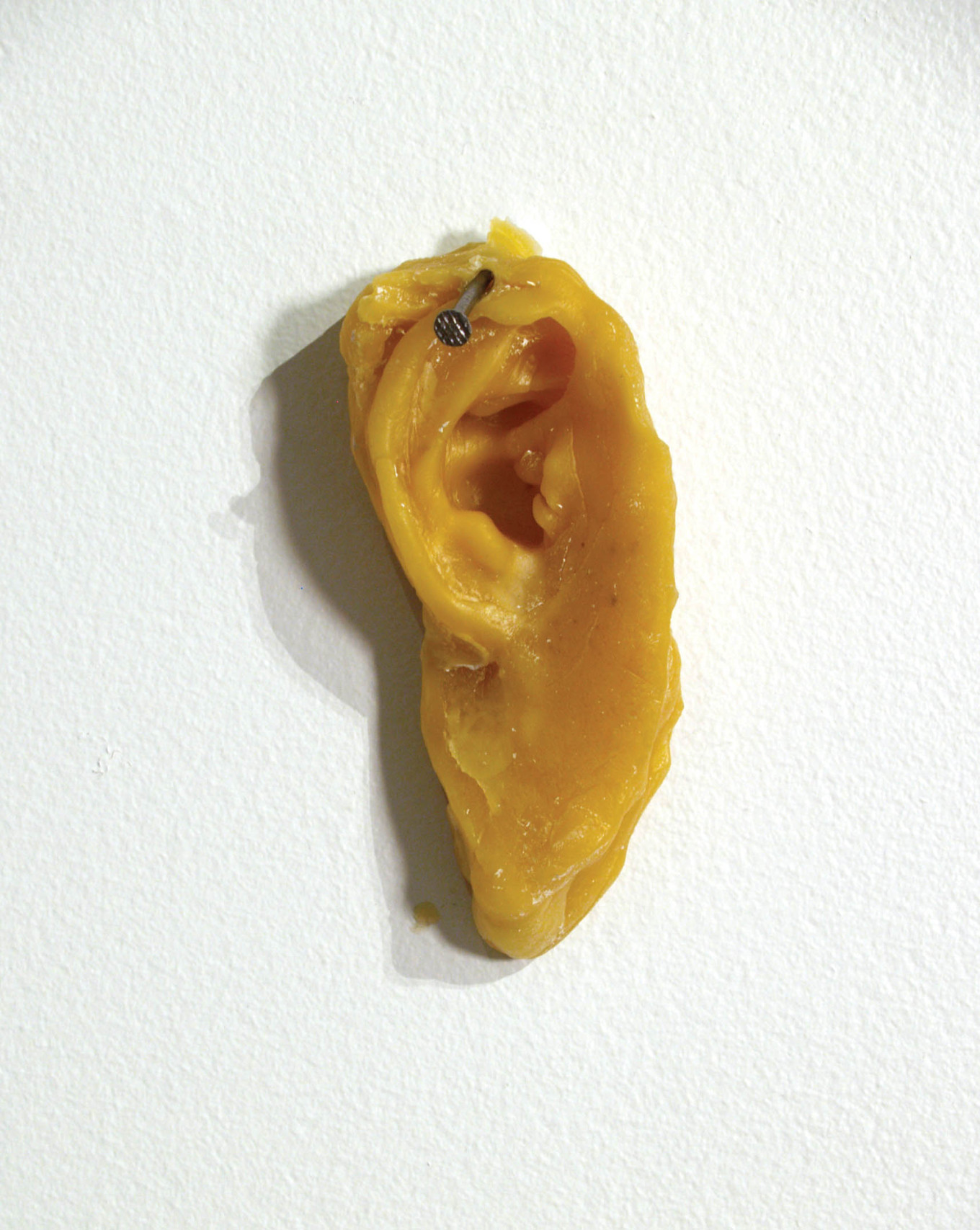SHARDS: JUDY WATSON, YHONNIE SCARCE, NICI CUMPSTON
Evidential & elemental: cutting to the corrosive core of life itself
Curator Mary Knights
South Australian School of Art Gallery (SASA) 30 September – 24 October 2008
![(left+right) Judy Watson 'Salt In The Wound' [detail]; (centre) Yhonnie Scarce 'Family Portrait' 2008 [detail]. Image © The Artists](http://concatenate.net.au/shards/files/page18-shards2.jpg)
Image © The Artists
Corrosion is at the core of things, that process that once begun seems to accelerate towards dissolution, the reduction of things to their fundamental forms. The elemental is here everywhere in evidence, black carbon, rusty ochres, bloody ink, the crusty surfaces, the tearing of paper and the salt crystals heaped in tidal lines along the cool concrete floor.
A large ochre form is crusted on the floor, an unhealed wound its’ centre heaped with bright salt crystals, a fragile ti tree fence (shelter, hide?) hangs nearby in a sinuous curve, on the wall next to it wax ears (cast from life) are pinned with galvanised nails to the wall, the connections between these elements tenuous but potent, unmistakable, Judy Watson’s salt in the wound could be our corrosive core; blood, rust and brutality rendered in powdery ochre and soft wax.
For the artists in Shards, Judy Watson, Yhonnie Scarce and Nici Cumpston fragmentation becomes not breakage but a loosing of bonds and an examination of the spaces revealed, a productive process of reconstruction. These elementals of colour and texture, of the organic processes of growth and entropy in the work resonate and reflect, building a web of multiplying interconnections and opening up spaces and pathways for this accretion of meanings.
Watson’s artist’s book, a preponderance of aboriginal blood, shown as sixteen etchings uses archival material on the aboriginal protection system exploring these systems of bureaucratic control over Indigenous people and the complex classifications of proportions of aboriginal and white blood that lay at its core. The etchings are quiet, stained with bloody ink, the work shocking in the absolute matter-of-factness of systemic oppression; the use of “breed” on forms to refer to indigenous people, the casual arrogance of an official who simply cannot understand why an indigenous woman excepted from the protection act might think this entitles her to vote. Reading the work is an oppressive experience, the ink almost obscures the text in some cases forcing the viewer into an uneasily close intimacy, it feels like entrapment, smothering in layers of paper. Watson’s use of the chine colle process is refined and potent layering and binding the language of control to the base body and overlaying this with the red ink that seeps and stains exposing the fear of the irruptive other that drives this need for classification and control.
Where blood and alcohol flow as a connecting thread through Watson and Scarce’s work, water or its absence is the core of Cumpston’s large scale images of Nookamka (Lake Bonney) where drought and water mismanagement have starved the lake possibly beyond saving, yet the pastel tones of Cumpston’s images of dead and dying trees on the exposed lake bed robs these of the urgency that would crystallise these into powerful images.
Watson’s women’ neckbands and asmodea is revelatory, sunk into the stained ochre ground of the raw canvas, the monolithic form of Goya’s mountain Asmodea is rendered in an odd refulgent green, over and above the dark outline of an indigenous woman’s neckband floats like an umbilicus. With this connection of a woman’s adornment and Goya’s history, it is impossible not to think of Goya’s depictions of the individual and particular horrors of war or to resist the almost visceral realisation that there was a war and it was here. Yet the neckbands float as if in flight, out of the frame, loosed and unbound.
Jemima Kemp
Published: Artlink volume 28 No. 4
Nov/Jan 2008/2009
—————————-
Judy Watson
women’s neckbands, asmodea 2008. pigment, acrylic and carbon on canvas 213×139.8 cm.
a preponderance of aboriginal blood, 2005
Artist’s book sixteen etchings with chine colle- each page signed and numbered verso page. 42.0 x30.5 cm in folio 43.0 x32.0 cm (closed) 71.3×99.2 cm open. Special edition commissioned by State Library of Queensland and edition of five numbered 1/5 to 5/5 and 5a/ps published by numero uno publications printers: Suzanne Danaher, Tricia Hatcher bound by Fred Pohlmann.
salt in the wound, 2008. Ochre, salt, brush, wax, wire, nails, string. Dimensions variable.
Yhonnie Scarce
Family Portrait, 2008
Installation, dimensions variable, mixed media.
Nici Cumpston
Cultural Landscape- Nookamka I, 2008 glicee print on canvas 177 x65 cm.
Cultural Landscape- Nookamka ii, 2008 glicee print on canvas 177 x65 cm.
Cultural Landscape- Nookamka iii,2008 glicee print on canvas 177 x65 cm.
Keeper, 2008 glicee print on Hahnemuller paper 177 x 65 cm.
Cold Weather, 2008 glicee print on Hahnemuller paper 177 x 65 cm.


Comments (0)